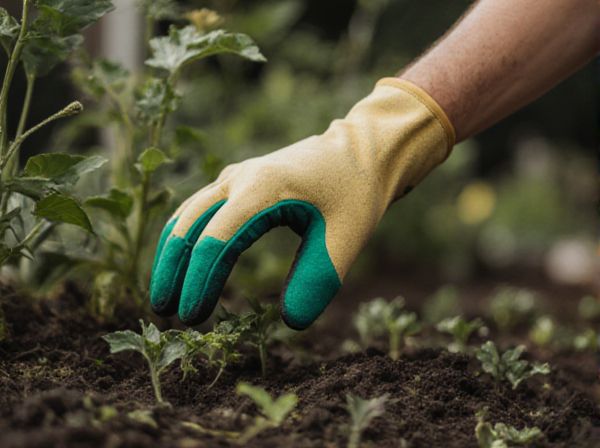
Canker vs Scab Illustration
Canker and scab are plant diseases caused by different pathogens resulting in distinct symptoms; canker typically appears as sunken, dead areas on stems or branches, while scab causes rough, scabby lesions on fruits and leaves. Effective management of canker involves pruning infected parts and improving plant vigor, whereas scab control relies on fungicide applications and resistant cultivars. Understanding the specific disease symptoms ensures accurate diagnosis and targeted treatment to minimize crop damage.
Table of Comparison
| Feature | Canker | Scab |
|---|---|---|
| Definition | Localized necrotic lesion on stems or branches caused by fungal or bacterial pathogens. | Fungal disease causing rough, scabby lesions mainly on fruit surfaces. |
| Common Pathogens | Fungi (e.g., Nectria, Cytospora), Bacteria (e.g., Pseudomonas). | Fungi (e.g., Venturia inaequalis for apple scab). |
| Host Plants | Trees and woody plants (e.g., apple, cherry, oak). | Fruit trees (e.g., apple, pear, quince). |
| Symptoms | Sunken, dead areas on bark, can cause branch dieback. | Dark, corky spots on fruit and leaves, leading to fruit deformation. |
| Spread Mechanism | Infected pruning wounds, insect damage, rain splash. | Airborne spores, rain splash, infected plant debris. |
| Impact | Structural damage to branches and stems, reduced plant vigor. | Reduced fruit quality and marketability. |
| Control Methods | Prune infected areas, fungicides, improve plant health. | Fungicide sprays, resistant cultivars, sanitation. |
Understanding Canker and Scab: Key Differences
Canker typically refers to localized necrotic lesions on plant stems or branches caused by fungal or bacterial pathogens, resulting in sunken, discolored areas that disrupt nutrient flow. Scab, commonly seen as a superficial fungal infection, primarily affects fruit and leaves, producing raised, crusty lesions that impact appearance and marketability. Recognizing these distinctions aids in accurate diagnosis and targeted disease management strategies for crops.
Common Causes of Canker and Scab in Gardens
Canker in gardens is commonly caused by fungal pathogens such as Botryosphaeria, Nectria, and Cytospora, which infect through wounds and stressed plant tissues. Scab typically results from infections by the fungus Venturia, particularly Venturia inaequalis on apples and related species, thriving in wet and humid conditions. Both diseases are exacerbated by environmental stressors like poor air circulation and improper pruning practices.
Symptoms: Identifying Canker vs Scab
Canker symptoms typically include sunken, dead areas on stems, branches, or trunks with dark, discolored lesions, often accompanied by oozing sap and dieback of affected tissues. Scab presents as rough, raised, and olive-green to black lesions on leaves, fruits, or stems, causing deformities and reduced quality. Accurate identification relies on observing lesion texture and discoloration, with canker showing sunken, necrotic spots and scab exhibiting scabby, crusty growths.
Plants Most Susceptible to Canker and Scab
Plants most susceptible to canker include stone fruit trees such as cherries, peaches, and plums, as well as citrus species prone to bacterial canker. Scab primarily affects apple and pear trees, causing lesions on fruit and foliage that reduce crop quality. Understanding host specificity aids in targeted disease management and prevention strategies for orchards and gardens.
Environmental Factors Influencing Disease Development
Canker development is strongly influenced by environmental factors such as excessive moisture, wounded plant tissue, and temperature fluctuations that create ideal conditions for pathogen invasion and proliferation. Scab disease thrives in warm, humid climates where prolonged leaf wetness promotes fungal spore germination and infection on fruit and foliage. Understanding microclimatic conditions like rainfall, humidity, and temperature is crucial for managing both canker and scab outbreaks effectively.
Preventative Measures for Canker and Scab
Preventative measures for canker include maintaining tree health through proper watering, pruning to improve air circulation, and applying fungicides early in the growing season. To prevent scab, use resistant plant varieties, remove fallen leaves and fruit debris, and apply recommended fungicidal sprays during periods of wet weather. Consistent monitoring and sanitation significantly reduce the risk of both canker and scab infections in susceptible plants.
Integrated Pest Management Strategies
Integrated Pest Management (IPM) strategies for canker and scab emphasize accurate disease identification, monitoring, and the use of resistant varieties to reduce pathogen spread. Targeted cultural practices such as pruning infected limbs, improving air circulation, and optimizing irrigation limit fungal development and infection cycles. Chemical controls, including timely fungicide applications based on disease forecasting models, complement cultural methods to enhance overall disease suppression.
Organic and Chemical Treatment Options
Canker, caused by fungal infections such as Cytospora and Nectria, responds well to organic treatments like neem oil and copper-based fungicides combined with proper pruning to improve air circulation. Scab, particularly apple scab caused by Venturia inaequalis, is often managed through applications of sulfur or copper sprays in organic gardening, while chemical options include systemic fungicides like myclobutanil and captan for more effective control. Both diseases benefit from integrated pest management approaches that combine organic and chemical treatments with cultural practices to reduce pathogen spread and improve plant health.
Long-Term Impact of Canker and Scab on Plant Health
Canker causes deep lesions that disrupt the vascular system, leading to chronic decline and dieback in affected plants over several growing seasons. Scab primarily affects the surface tissue, causing cosmetic damage but potentially reducing photosynthetic efficiency and fruit quality if infections are severe. Long-term canker infections often result in structural weakness and increased susceptibility to secondary pathogens, while scab's impact is generally less severe but can still diminish overall plant vigor.
Frequently Asked Questions about Canker and Scab
Canker and scab are common plant diseases affecting trees and crops, with canker causing sunken, dead areas on stems or branches due to fungal or bacterial infection, while scab primarily affects fruit surfaces, leading to rough, discolored spots caused by fungal pathogens such as Venturia inaequalis in apples. Frequently asked questions often address symptoms distinction, treatment options involving fungicides or pruning, and prevention methods including resistant cultivars and proper sanitation practices. Both diseases require early detection and management to minimize crop loss and maintain plant health.
Canker vs Scab Infographic

 gardendif.com
gardendif.com